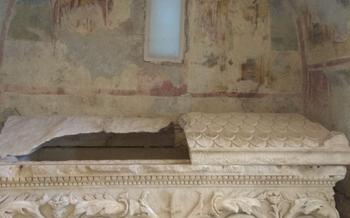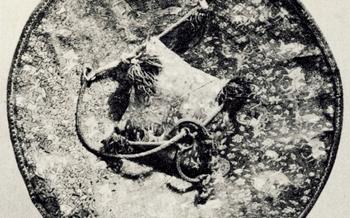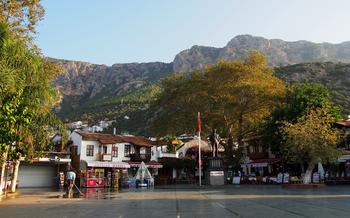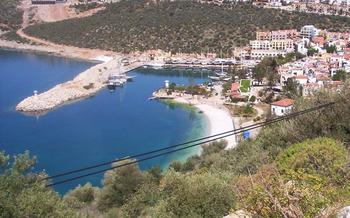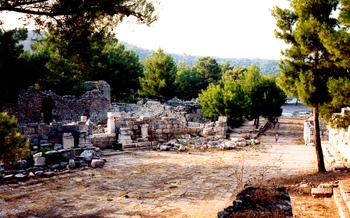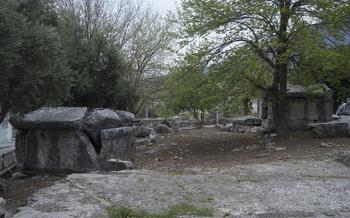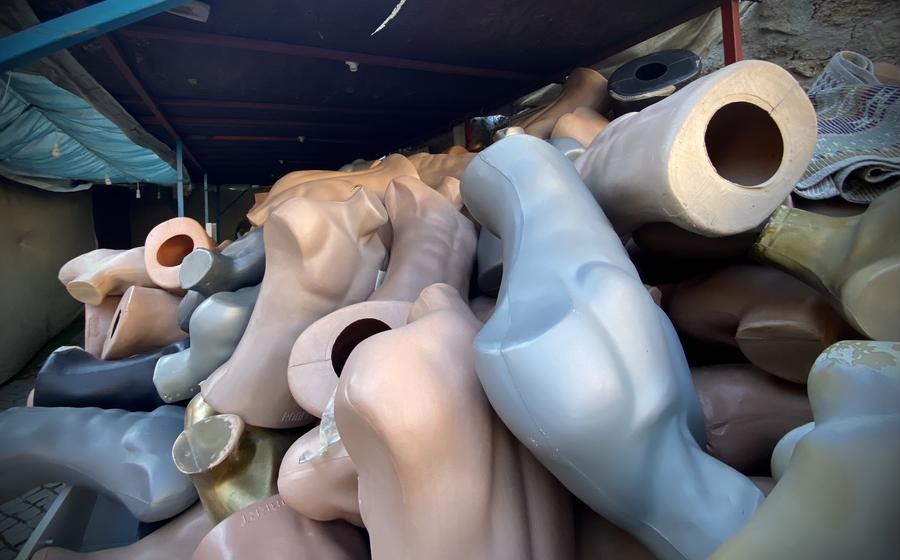
Lycian Rock Tombs in Myra
- The Lycian Rock Tombs: A Timeless Legacy
- Unveiling the City of Myra
- Transportation to Myra
- From Antalya:
- From Kas:
- From Fethiye:
- Parking at the Site:
- Exploring the Tombs
- Mesmerizing Views and Landscapes
- Unraveling the Lycian Civilization
- Ancient Amphitheater of Myra: A Stage of History
- St. Nicholas the Wonderworker:
- Photography Tips and Tricks
- Exploring Nearby Towns
- Respecting the Ancient Legacy
- Virtual Tours and Online Resources:
- Insider Tip: Unveiling a Hidden Gem
The Lycian Rock Tombs: A Timeless Legacy
Etched into the sheer cliffs surrounding the ancient city of Myra, the Lycian Rock Tombs stand as a testament to the ingenuity and artistry of the ancient Lycians. These remarkable tombs, dating back to the 4th century BC, offer a glimpse into the rich history and culture of this enigmatic civilization.
The Lycian Rock Tombs are unique in their design and architecture, reflecting the blending of various cultural influences. Elements of Greek, Persian, and Anatolian styles can be seen in the intricate carvings and facades of the tombs, showcasing the diversity and cosmopolitan nature of the Lycian society.
Their rarity adds to their allure, as rock-cut tombs of this scale and grandeur are found in very few places worldwide. The tombs were meticulously carved into the solid rock, creating elaborate chambers and niches to house the remains of the deceased.
The mystique surrounding the ancient Lycians, who built these tombs, further enhances their allure. The Lycians were known for their seafaring prowess, trading skills, and their unique language and alphabet. Their tombs offer tantalizing clues about their beliefs, customs, and way of life, inviting visitors to unravel the mysteries of this ancient civilization.
Unveiling the City of Myra
Myra, an ancient city that once stood as a prominent member of the Lycian League, unveils its rich historical tapestry through archaeological excavations and discoveries. As you explore the city, you'll encounter fascinating remnants of its glorious past. The well-preserved amphitheater, a testament to Roman engineering, captivates visitors with its impressive architecture and echoes of ancient performances.
Step into the necropolis, where the Lycian Rock Tombs stand as silent guardians of the city's history. These intricate rock-cut structures, some resembling miniature temples, offer a glimpse into the beliefs and customs of the Lycians. Discover the significance of the city's connection to Saint Nicholas, the beloved patron saint of sailors and children, whose legacy continues to inspire and touch hearts worldwide.
Transportation to Myra
Myra's allure draws visitors from across the globe, and reaching this ancient city is a breeze. From popular tourist hubs like Antalya, Kas, and Fethiye, a scenic journey awaits.
From Antalya:
-
Embrace the flexibility of renting a car and enjoy a leisurely drive, immersing yourself in the captivating landscapes along the way. The journey takes approximately 2 hours and 30 minutes, covering a distance of 145 kilometers.
-
Opt for the convenience of a guided tour, allowing you to sit back, relax, and absorb the region's rich history and culture as your knowledgeable guide narrates the journey. Tours typically depart from Antalya in the morning and return in the evening.
From Kas:
-
Embark on a picturesque 1-hour and 15-minute drive, traversing 80 kilometers of winding roads that offer breathtaking views of the Mediterranean Sea. Car rentals are readily available in Kas, providing the freedom to explore at your own pace.
-
Experience the scenic coastal route by hopping on a local bus. Buses depart regularly from Kas's main bus station and offer a budget-friendly option with a travel time of approximately 1 hour and 30 minutes.
From Fethiye:
-
Rent a car and embark on a scenic 2-hour and 30-minute drive, covering a distance of 150 kilometers. The route takes you through charming villages and offers panoramic views of the Taurus Mountains.
-
Take advantage of the frequent bus service connecting Fethiye to Myra. Buses depart from Fethiye's main bus station and provide a convenient and affordable mode of transport, with a travel time of approximately 3 hours.
Parking at the Site:
- Ample parking space is available near the Lycian Rock Tombs, ensuring a hassle-free visit. The designated parking area is located within walking distance of the site's entrance, allowing for easy access to the ancient wonders that await.
Exploring the Tombs
As you walk through the necropolis, you'll encounter a variety of tombs, each with its own unique design and features. Some tombs are simple in structure, with a single chamber carved into the rock, while others are more elaborate, with multiple chambers and intricate carvings. The tombs are arranged in rows, and some are even stacked on top of each other, creating a visually impressive sight.
Among the highlights of the necropolis are the so-called "temple tombs," which feature a distinctive design resembling a Greek temple. These tombs are typically larger and more ornate than the others, and often have intricate carvings depicting scenes from mythology or daily life.
Within the tombs, archaeologists have discovered a wealth of artifacts, including jewelry, pottery, and coins. These artifacts provide valuable insights into the lives and customs of the Lycians. Some of the tombs also contain inscriptions, which have helped scholars to learn more about the history of Myra and the Lycian League.
To capture stunning photographs of the tombs, it's best to visit during the golden hours of sunrise or sunset, when the warm light casts a beautiful glow on the rock-cut facades. Using a wide-angle lens will allow you to capture the grandeur of the necropolis, while a telephoto lens can be used to zoom in on the intricate details of the carvings.
Mesmerizing Views and Landscapes
Myra's allure extends beyond its ancient tombs, as it boasts a breathtaking natural backdrop that captivates visitors with its scenic vistas. Nestled amidst verdant mountains and lush greenery, the city offers a panoramic canvas of natural beauty. As you ascend to the necropolis, the landscape unfolds before you, revealing a tapestry of colors and textures that will leave you in awe.
From the elevated vantage point of the tombs, you'll be rewarded with unparalleled vistas that stretch for miles. The panoramic views encompass the azure waters of the Mediterranean Sea, the rugged peaks of the Taurus Mountains, and the fertile plains that surround Myra. Capture the essence of this breathtaking scenery with your camera, ensuring you immortalize the memories of your visit to this enchanting destination.
Nature enthusiasts will find ample opportunities to indulge their passion for photography in Myra. The play of light and shadow on the ancient tombs, the vibrant hues of the surrounding landscape, and the stunning sunsets that paint the sky with fiery colors make for exceptional photographic moments. Seize the chance to capture the essence of this magical place through your lens.
Beyond the necropolis, the region surrounding Myra offers a wealth of additional scenic experiences. Take advantage of your visit to explore nearby attractions that will further enhance your appreciation for the natural beauty of this corner of Turkey. Discover hidden coves and pristine beaches along the Mediterranean coast, embark on hiking trails that lead you through picturesque landscapes, and marvel at the cascading waterfalls and lush forests that dot the region.
Unraveling the Lycian Civilization
The Lycian civilization, which flourished in ancient Anatolia, was a remarkable society that left an indelible mark on the region's history and culture. Myra, as a prominent city within the Lycian League, played a pivotal role in shaping the Lycian identity and legacy. The Lycians were known for their unique language, customs, and beliefs, which set them apart from their neighbors. Archaeological discoveries have shed light on their sophisticated writing system, intricate religious practices, and advanced maritime skills. The Lycian Rock Tombs, with their intricate carvings and inscriptions, offer a glimpse into their artistic prowess and reverence for their ancestors. By exploring Myra and its surroundings, visitors can gain a deeper understanding of this fascinating civilization and its enduring influence on the region.
Ancient Amphitheater of Myra: A Stage of History
Amidst the impressive Lycian Rock Tombs, the ancient amphitheater of Myra stands as a testament to the city's rich history and grandeur. Constructed in the 2nd century AD, this architectural marvel boasts a well-preserved structure that offers a glimpse into the past. With a seating capacity of approximately 13,000 spectators, the amphitheater hosted an array of events, including gladiatorial contests, theatrical performances, and civic gatherings.
The impressive stone tiers rise gracefully, providing spectators with an unobstructed view of the central arena. The stage area, once adorned with intricate carvings and sculptures, still captivates visitors with its grandeur. Although time and natural elements have left their mark on the amphitheater, its architectural integrity remains intact, allowing visitors to envision the vibrant atmosphere that once filled this ancient venue.
Ongoing restoration efforts are carefully preserving the amphitheater, ensuring that future generations can continue to marvel at its beauty and historical significance. Capture unique perspectives of this architectural gem by exploring different vantage points, both from within the seating area and from the surrounding hills. Let the ancient amphitheater of Myra transport you back in time, as you imagine the roar of the crowd and the spectacle that unfolded on its stage.
St. Nicholas the Wonderworker:
Myra is not just renowned for its ancient tombs but also holds a special connection to a beloved figure, St. Nicholas. Born in the 3rd century AD, St. Nicholas dedicated his life to helping those in need. His generosity and kindness earned him the title of "Wonderworker," and he became the patron saint of sailors and children.
Historical accounts describe St. Nicholas as a compassionate and selfless individual who often performed miracles. He is said to have saved sailors from shipwrecks, protected children from harm, and provided for the poor and needy. His reputation for kindness and generosity spread far and wide, inspiring the legend of Santa Claus.
Over time, the figure of Santa Claus evolved from the stories of St. Nicholas, becoming a symbol of gift-giving and holiday cheer. The tradition of exchanging gifts on December 6th, St. Nicholas' feast day, continues to be observed in many countries around the world.
In Myra, the memory of St. Nicholas is deeply cherished. Locals celebrate his life with annual festivals and processions, honoring his legacy as the protector of children and the patron saint of the city. Visiting Myra allows you to connect with the origins of this beloved figure and experience the profound respect and admiration that the local community holds for St. Nicholas.
Photography Tips and Tricks
Capturing the timeless beauty of the Lycian Rock Tombs and the ancient amphitheater of Myra requires a keen eye and an understanding of photography techniques.
-
Golden Hour Magic: Plan your visit during the golden hours of sunrise or sunset to capture the warm, diffused light that casts a magical glow on the tombs.
-
Composition is Key: Experiment with different angles and perspectives to create dynamic compositions. Use the tombs' unique shapes and positioning to frame your shots.
-
Embrace Negative Space: Incorporate negative space into your compositions to create a sense of depth and drama. The vast expanse of the sky or the surrounding landscape can enhance the impact of your images.
-
Capture Details: Don't overlook the intricate details that adorn the tombs and amphitheater. Close-up shots can reveal the delicate carvings, inscriptions, and architectural elements that make these structures so remarkable.
-
Drone Perspectives: If you have access to a drone, take advantage of the aerial perspective to capture breathtaking panoramic shots of the necropolis and the surrounding landscape.
-
Essential Gear: Bring a sturdy tripod to stabilize your camera for sharp shots, especially in low-light conditions. A wide-angle lens is ideal for capturing the grandeur of the tombs and amphitheater, while a telephoto lens can help you isolate specific details.
-
Respect the Environment: While capturing your shots, be mindful of your surroundings and avoid disturbing the natural beauty of the site.
Exploring Nearby Towns
As you delve deeper into the history and beauty of Myra, don't miss the opportunity to explore the charming towns nestled in its vicinity. Demre, Kas, and Kalkan, each with its unique allure, await your discovery.
Demre, the ancient city of Myra, is a treasure trove of historical sites, including the impressive Church of St. Nicholas, where the beloved saint was once a bishop. Immerse yourself in the town's rich history and religious significance as you wander through its enchanting streets.
Kas, a picturesque harbor town, beckons with its crystal-clear waters, inviting you to dive into the vibrant marine life that thrives beneath the surface. Explore the town's charming boutiques, savor delicious seafood delicacies, and unwind in the tranquil atmosphere that envelops this coastal gem.
Kalkan, perched on a hillside overlooking the Mediterranean Sea, offers breathtaking panoramic views that will leave you spellbound. Discover hidden coves and pristine beaches, perfect for swimming, sunbathing, and creating unforgettable memories.
To create a comprehensive itinerary, consider combining your visit to Myra with these neighboring towns. Local transportation options, such as buses or taxis, make it easy to travel between these destinations, allowing you to craft a diverse and enriching experience that encompasses history, nature, and cultural charm.
Respecting the Ancient Legacy
As we explore the Lycian Rock Tombs and the ancient city of Myra, it is imperative to remember that we are treading on hallowed ground. These sites are not merely tourist attractions but remnants of a rich and vibrant civilization that deserves our utmost respect and care. To ensure the preservation of this precious heritage for generations to come, responsible tourism practices are paramount.
Avoid any actions that may damage or deface the tombs or surrounding areas. Refrain from graffiti, littering, or removing any artifacts or stones from the site. Respect the sanctity of these ancient burial grounds by maintaining silence and refraining from disturbing the tranquility of the المكان.
Furthermore, be mindful of your impact on the local environment and communities. Choose transportation options that minimize your carbon footprint, and support local businesses that prioritize sustainability. Engage with the locals with respect and curiosity, learning about their customs and traditions.
By embracing responsible tourism practices, we can help protect and preserve the Lycian Rock Tombs and Myra's legacy for future generations to appreciate and learn from.
Virtual Tours and Online Resources:
While not everyone has the opportunity to witness the Lycian Rock Tombs and Myra in person, virtual tours and online resources offer a remarkable alternative. Several reputable websites and platforms provide immersive experiences that allow you to explore these ancient wonders from the comfort of your own home.
Immerse yourself in 360-degree panoramic tours that let you navigate the necropolis, step inside the tombs, and admire the intricate carvings up close. These virtual journeys offer a unique perspective and a sense of presence that traditional photographs and videos cannot match.
In addition to virtual tours, numerous online resources provide in-depth information about the Lycian civilization, the history of Myra, and the significance of the rock tombs. Explore interactive maps, read scholarly articles, and uncover the latest archaeological findings. These resources offer a wealth of knowledge and help you delve deeper into the fascinating world of ancient Lycia.
By embracing the power of technology, you can embark on a virtual pilgrimage to Myra and learn about its rich history and cultural heritage without leaving your home. These online experiences are not only educational but also inspiring, igniting a passion for exploration and a desire to one day witness these wonders in person.
Insider Tip: Unveiling a Hidden Gem
While exploring the wonders of Myra, don't miss the opportunity to uncover a hidden gem nestled nearby - the ancient city of Aperlai. Located just a short drive from Myra, Aperlai offers a glimpse into another chapter of Lycian history. Wander amidst its ruins, marvel at the well-preserved theater, and immerse yourself in the tranquility of this lesser-known site. As you explore Aperlai, let your imagination soar as you envision the bustling streets and vibrant community that once thrived within its walls. This hidden gem awaits those who seek to venture beyond the beaten path and discover the lesser-known treasures of Turkey's rich history.
